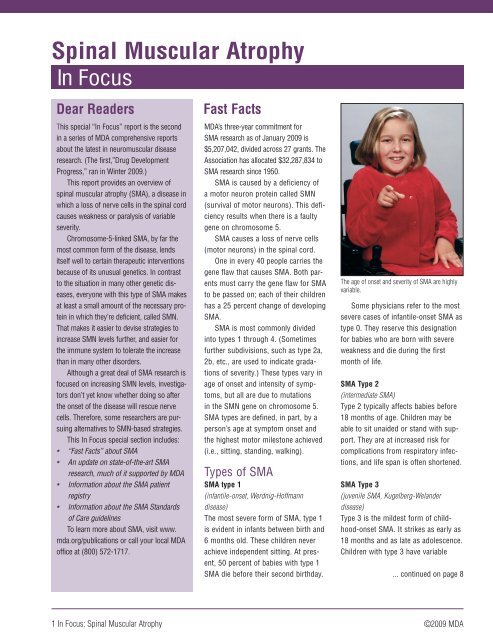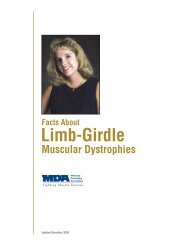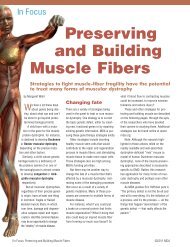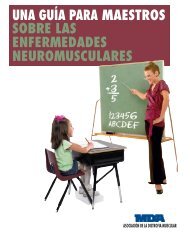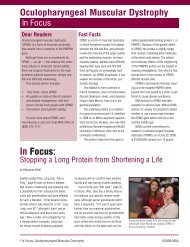Spinal Muscular Atrophy (PDF) - Muscular Dystrophy Association
Spinal Muscular Atrophy (PDF) - Muscular Dystrophy Association
Spinal Muscular Atrophy (PDF) - Muscular Dystrophy Association
You also want an ePaper? Increase the reach of your titles
YUMPU automatically turns print PDFs into web optimized ePapers that Google loves.
<strong>Spinal</strong> <strong>Muscular</strong> <strong>Atrophy</strong><br />
In Focus<br />
Dear Readers<br />
This special “In Focus” report is the second<br />
in a series of MDA comprehensive reports<br />
about the latest in neuromuscular disease<br />
research. (The first,”Drug Development<br />
Progress,” ran in Winter 2009.)<br />
This report provides an overview of<br />
spinal muscular atrophy (SMA), a disease in<br />
which a loss of nerve cells in the spinal cord<br />
causes weakness or paralysis of variable<br />
severity.<br />
Chromosome-5-linked SMA, by far the<br />
most common form of the disease, lends<br />
itself well to certain therapeutic interventions<br />
because of its unusual genetics. In contrast<br />
to the situation in many other genetic diseases,<br />
everyone with this type of SMA makes<br />
at least a small amount of the necessary protein<br />
in which they’re deficient, called SMN.<br />
That makes it easier to devise strategies to<br />
increase SMN levels further, and easier for<br />
the immune system to tolerate the increase<br />
than in many other disorders.<br />
Although a great deal of SMA research is<br />
focused on increasing SMN levels, investigators<br />
don’t yet know whether doing so after<br />
the onset of the disease will rescue nerve<br />
cells. Therefore, some researchers are pursuing<br />
alternatives to SMN-based strategies.<br />
This In Focus special section includes:<br />
• “Fast Facts” about SMA<br />
• An update on state-of-the-art SMA<br />
research, much of it supported by MDA<br />
• Information about the SMA patient<br />
registry<br />
• Information about the SMA Standards<br />
of Care guidelines<br />
To learn more about SMA, visit www.<br />
mda.org/publications or call your local MDA<br />
office at (800) 572-1717.<br />
Fast Facts<br />
MDA’s three-year commitment for<br />
SMA research as of January 2009 is<br />
$5,207,042, divided across 27 grants. The<br />
<strong>Association</strong> has allocated $32,287,834 to<br />
SMA research since 1950.<br />
SMA is caused by a deficiency of<br />
a motor neuron protein called SMN<br />
(survival of motor neurons). This deficiency<br />
results when there is a faulty<br />
gene on chromosome 5.<br />
SMA causes a loss of nerve cells<br />
(motor neurons) in the spinal cord.<br />
One in every 40 people carries the<br />
gene flaw that causes SMA. Both parents<br />
must carry the gene flaw for SMA<br />
to be passed on; each of their children<br />
has a 25 percent change of developing<br />
SMA.<br />
SMA is most commonly divided<br />
into types 1 through 4. (Sometimes<br />
further subdivisions, such as type 2a,<br />
2b, etc., are used to indicate gradations<br />
of severity.) These types vary in<br />
age of onset and intensity of symptoms,<br />
but all are due to mutations<br />
in the SMN gene on chromosome 5.<br />
SMA types are defined, in part, by a<br />
person’s age at symptom onset and<br />
the highest motor milestone achieved<br />
(i.e., sitting, standing, walking).<br />
Types of SMA<br />
SMA type 1<br />
(infantile-onset, Werdnig-Hoffmann<br />
disease)<br />
The most severe form of SMA, type 1<br />
is evident in infants between birth and<br />
6 months old. These children never<br />
achieve independent sitting. At present,<br />
50 percent of babies with type 1<br />
SMA die before their second birthday.<br />
The age of onset and severity of SMA are highly<br />
variable.<br />
Some physicians refer to the most<br />
severe cases of infantile-onset SMA as<br />
type 0. They reserve this designation<br />
for babies who are born with severe<br />
weakness and die during the first<br />
month of life.<br />
SMA Type 2<br />
(intermediate SMA)<br />
Type 2 typically affects babies before<br />
18 months of age. Children may be<br />
able to sit unaided or stand with support.<br />
They are at increased risk for<br />
complications from respiratory infections,<br />
and life span is often shortened.<br />
SMA Type 3<br />
(juvenile SMA, Kugelberg-Welander<br />
disease)<br />
Type 3 is the mildest form of childhood-onset<br />
SMA. It strikes as early as<br />
18 months and as late as adolescence.<br />
Children with type 3 have variable<br />
... continued on page 8<br />
1 In Focus: <strong>Spinal</strong> <strong>Muscular</strong> <strong>Atrophy</strong><br />
©2009 MDA
In Focus:<br />
<strong>Spinal</strong> <strong>Muscular</strong> <strong>Atrophy</strong> Research<br />
by Margaret Wahl<br />
Christian Lorson, above left, an MDA grantee at<br />
the University of Missouri-Columbia, is working<br />
on several strategies for SMA. Two of them<br />
involve increasing production of full-length, functional<br />
SMN protein. The third involves improving<br />
the stability of a short version of SMN.<br />
This decade, for the first time, scientific<br />
research in spinal muscular atrophy (SMA)<br />
has yielded enough information to allow<br />
the pursuit of several avenues of disease<br />
treatment and prevention.<br />
Most are centered around increasing<br />
cellular levels of a protein called SMN<br />
(survival of motor neuron), first identified<br />
in the mid-1990s as the root cause of<br />
almost all cases of SMA.<br />
A few scientists are studying exactly what<br />
SMN does to see if its absence might be compensated<br />
for via some other gene or protein.<br />
The curious case of<br />
a backup gene<br />
During the 1990s, investigators, many<br />
of whom had MDA support, uncovered<br />
a fundamental clue about SMA that<br />
would have profound implications for<br />
its treatment: While everyone with SMA<br />
lacked or had mutations in genes known<br />
as SMN1, located on chromosome 5,<br />
everyone with the disease also had<br />
at least one functional copy of a gene<br />
called SMN2 located nearby.<br />
2 In Focus: <strong>Spinal</strong> <strong>Muscular</strong> <strong>Atrophy</strong> ©2009 MDA
Researchers soon learned the difference<br />
between SMN1 and SMN2: Most<br />
of the protein produced from the DNA<br />
instructions carried by the SMN1 gene<br />
is so-called “full-length” SMN, a protein<br />
whose functions are incompletely<br />
understood but apparently necessary to<br />
the health of motor neurons. By contrast,<br />
most of the protein produced from<br />
neighboring SMN2 genes is a short form<br />
of SMN, which is not functional.<br />
The key word in that sentence is<br />
“most.” About 20 percent of the protein<br />
molecules produced from the SMN2<br />
gene are in fact full-length, fully functional<br />
SMN. And the more SMN2 activity<br />
there is, the better an organism tolerates<br />
the loss of SMN1.<br />
Researchers quickly learned that the<br />
number of SMN2 “backup gene” copies<br />
varies in the population in general. In<br />
people with SMA, who lack functional<br />
SMN1 genes, the more SMN2 copies<br />
someone has, the better he or she is<br />
likely to fare.<br />
SMN1<br />
DNA<br />
SMN2<br />
DNA<br />
SMN1<br />
RNA<br />
SMN2<br />
RNA<br />
full-length SMN<br />
SMN Proteins<br />
short SMN<br />
Genetic information moves from its storage form as DNA to a set of instructions known as RNA, from which<br />
protein molecules are made. Most of the RNA instructions from the SMN1 gene tell the cell to make fulllength<br />
SMN protein. Most of the instructions from the SMN2 gene tell the cell to make short SMN protein.<br />
Babies born with no SMN1 genes<br />
and one or two SMN2 genes usually<br />
have the very severe form of the disease<br />
known as type 1 SMA, in which<br />
severe weakness and respiratory muscle<br />
impairment usually lead to early death.<br />
Type 2 SMA is less severe and allows<br />
for a longer life span, albeit with disabilities,<br />
and people with this form of<br />
the disease generally have about three<br />
copies of SMN2.<br />
The least severe SMA cases, known<br />
as type 3 (with some physicians adding<br />
a type 4) generally occur when there are<br />
at least three SMN2 genes present.<br />
The correlation between number of<br />
SMN2 genes and severity of SMA, however,<br />
is only approximate. Research to<br />
identify other factors is under way.<br />
Just what SMN does in nerve or<br />
other cells, and whether its presence<br />
is required during development of the<br />
nervous system to prevent permanent<br />
damage, remain incompletely answered<br />
questions.<br />
Augmenting SMN by<br />
modifying SMN2 gene<br />
instructions<br />
For Adrian Krainer at Cold Spring Harbor<br />
Laboratory on New York’s Long Island,<br />
the preferred strategy to find a cure<br />
for SMA involves changing the SMN2<br />
Adrian Krainer, an MDA grantee at Cold Spring harbor (N.Y.) Laboratory, has been studying the process known as RNA splicing since 1983. He’s now applying his<br />
knowledge to SMA.<br />
3 In Focus: <strong>Spinal</strong> <strong>Muscular</strong> <strong>Atrophy</strong> ©2009 MDA
gene’s instructions by altering a process<br />
called splicing, a kind of molecular cutting<br />
and pasting that cells perform.<br />
“Changing the splicing that underlies<br />
the defect has a certain elegance,”<br />
says Krainer, who has MDA funding<br />
for this work and is collaborating with<br />
Isis, a drug development company in<br />
Carlsbad, Calif. However, he says, “there<br />
are different ways of solving the SMA<br />
problem, many approaches to pursue in<br />
parallel.”<br />
Since 1983, Krainer has been working<br />
on RNA splicing, a method cells use<br />
to refine a genetic message as it moves<br />
from its permanent form as DNA to a<br />
“rough draft” RNA molecule and then<br />
to one or more “final” RNA versions,<br />
known as messenger RNAs, that provide<br />
direct instructions for the cell to make<br />
protein molecules.<br />
One way to change how a cell<br />
splices the RNA on its way to becoming<br />
a final copy is by hiding parts of the<br />
RNA strand from the cell’s processing<br />
mechanism, thereby changing the final<br />
structure of the messenger RNA. Krainer<br />
and others accomplish this sleight of<br />
hand by using synthetic material called<br />
“antisense,” which specifically targets,<br />
sticks to and prevents a cell from “seeing”<br />
an RNA section.<br />
Without treatment, the section of<br />
the SMN2 gene called exon 6 is spliced<br />
SMN2 RNA<br />
Short SMN Protein<br />
directly to the section called exon 8, and<br />
exon 7 is left out of the final RNA. But<br />
using antisense to block a “clip out exon<br />
7” signal on the RNA coaxes the cell to<br />
include this critical exon and ultimately<br />
make full-length SMN protein.<br />
Krainer is now testing the various<br />
antisense molecules in two strains of<br />
laboratory mice with a disease closely<br />
resembling human SMA.<br />
Before proceeding toward human<br />
testing, which Krainer hopes will be<br />
within the next few years, he and his<br />
colleagues want to find out in the laboratory<br />
how important the timing of SMN<br />
treatment is and determine whether an<br />
increase in SMN after the onset of SMA<br />
can stop disease progression, or even<br />
reverse the disease process.<br />
Christian Lorson, an MDA grantee<br />
at the University of Missouri-Columbia,<br />
is also pursuing strategies to get more<br />
full-length SMN out of the SMN2 gene,<br />
although that’s not the only approach to<br />
SMA that intrigues him.<br />
Lorson says he’s working on several<br />
experimental approaches to treating<br />
SMA. Two of them, both aimed at<br />
changing splicing, are known as “transsplicing”<br />
and “bifunctional” RNAs.<br />
Rather than just masking part of the<br />
SMN2 RNA with antisense and hoping<br />
the cell will include exon 7, Lorson says<br />
he prefers to take a firmer approach to<br />
About 80 percent of the time, an RNA section called exon 7 is spliced out of the final instructions for the SMN2<br />
gene, resulting in production of a short version of the SMN protein. Many strategies to treat SMA are based on<br />
coaxing cells to include exon 7 in the instructions for SMN.<br />
“persuading” the cell to include exon<br />
7 by providing that piece of RNA along<br />
with blocking the original instructions.<br />
He and graduate student Tristan<br />
Coady developed an antisense molecule<br />
that overlaps the place where exon 6<br />
One way to change how a cell<br />
splices the RNA on its way to<br />
becoming a final copy is by hiding<br />
parts of the RNA strand from the<br />
cell’s processing mechanism.<br />
would be spliced to exon 8, preventing<br />
that from happening. The cell then has<br />
to “choose” between no splicing at all<br />
and splicing in the new exon 7 provided<br />
by the scientists, Lorson says. “When<br />
faced with that choice,” Lorson says, the<br />
cell considers splicing in the newly supplied<br />
exon 7 RNA (“trans-splicing”) the<br />
better option.<br />
Lorson’s lab group is also working<br />
on a variation of this strategy, using<br />
what he calls “bifunctional” RNAs. A<br />
bifunctional RNA molecule is a combination<br />
of a piece of antisense that targets<br />
the SMN2 gene at the point where<br />
exon 7 normally would be spliced out,<br />
tethered to another piece of RNA that<br />
specifically attracts cellular proteins normally<br />
involved in splicing that encourage<br />
exon 7 inclusion.<br />
Stabilizing short SMN<br />
Lorson, who has fingers in almost every<br />
part of the SMA research pie, also is<br />
working on a unique strategy that he<br />
says isn’t widely endorsed but is gaining<br />
adherents: improving the stability of<br />
the short protein made from the SMN2<br />
gene.<br />
In collaboration with Cheng-Wei<br />
Tom Chang, a chemist at Utah State<br />
University in Logan, Lorson and Virginia<br />
Mattis, another graduate student, are<br />
experimenting with antibiotics known as<br />
aminoglycosides, which cause cells to<br />
ignore, or “read through,” stop signals<br />
4 In Focus: <strong>Spinal</strong> <strong>Muscular</strong> <strong>Atrophy</strong> ©2009 MDA
Short SMN<br />
in RNA and make longer protein molecules.<br />
The “read-through” product made<br />
from the SMN2 gene still lacks exon 7,<br />
but it has a longer tail after exon 7 than<br />
it normally would have.<br />
“It may be that the read-through<br />
protein is not by itself intrinsically more<br />
functional,” Lorson says, “but in combination<br />
with full-length SMN, it enhances<br />
and stabilizes the normally low SMN levels.<br />
At the end of the day, we want more<br />
SMN protein, regardless of mechanism.<br />
That would be great.”<br />
His hypothesis, now being studied,<br />
is that the read-through SMN protein<br />
forms a two-part molecule with whatever<br />
full-length SMN is available, which<br />
improves its stability and function.<br />
Normally, he says, full-length SMN molecules<br />
associate with each other and<br />
form this type of two-part structure,<br />
but short SMN that lacks both exon 7<br />
and a longer tail can’t participate in this<br />
interaction.<br />
He says that if the benefit they’re<br />
seeing in cells “is coming about because<br />
of full-length SMN” rather than directly<br />
from short SMN, “that’s fine.”<br />
The next step will be to see if it helps<br />
SMN-deficient mice.<br />
Raising SMN levels by<br />
increasing total output<br />
from the SMN2 gene<br />
Because some percentage of output<br />
from the SMN2 gene is full-length<br />
SMN protein, it stands to reason that<br />
increasing the total output from the<br />
gene would raise levels of both compounds.<br />
One way to increase the activity of<br />
‘Tail’ Added<br />
An alternative to encouraging exon 7 inclusion in the final instructions for SMN would be lengthening the short<br />
form of SMN by adding a “tail” to it.<br />
a gene is with compounds known as<br />
histone deacetylase inhibitors, or HDAC<br />
inhibitors, which keep DNA messages<br />
open for transcription into RNA and<br />
ultimately cause more protein molecules<br />
to be made. Several ongoing drug<br />
trials in people with SMA are making<br />
use of this phenomenon.<br />
Sodium phenylbutyrate and valproic<br />
acid are in this category and are being<br />
tested in patients. The Boston pharmaceutical<br />
company Paratek is investigating<br />
whether antibiotics in the tetracycline<br />
family have HDAC inhibitory activity<br />
and can increase SMN production.<br />
According to a 2008 press release, the<br />
company has been encouraged by early<br />
evidence.<br />
Elliot Androphy, who has MDA support<br />
for SMA research at the University<br />
of Massachusetts-Worcester, believes<br />
HDAC inhibitors “hold promise” but<br />
that they also come with some caveats.<br />
“It’s an idea with potential and<br />
some experiments suggest these may<br />
be of benefit,” he says. “But we really<br />
don’t know how they may be working.”<br />
Androphy and others are concerned<br />
about the lack of specificity of HDAC<br />
inhibitors, which are likely to increase<br />
output from a number of genes, not<br />
just the SMA target gene.<br />
Transferring genes<br />
or stem cells<br />
Another strategy for raising full-length<br />
SMN levels is to deliver the compound<br />
via genes that make it, using stem cells<br />
or other delivery vehicles.<br />
California Stem Cell in Irvine is<br />
developing cell transplant therapies and<br />
has named SMA and ALS (amyotrophic<br />
lateral sclerosis) as its first targets.<br />
According to Chief Operating Officer<br />
Chris Airriess, the company hopes to<br />
test stem cells in type 1 SMA patients<br />
later this year.<br />
At the U.S. Food and Drug<br />
Administration, Jakob Reiser has MDA<br />
support to study the delivery of the<br />
SMN1 gene via gene therapy. Reiser, a<br />
molecular biologist who specializes in<br />
developing viral gene delivery vehicles,<br />
is working closely with neurosurgeon<br />
Nicholas Boulis at Emory University in<br />
Atlanta.<br />
Reiser says they’ll inject the SMN1<br />
gene at various time points into mice<br />
that have an SMA-like disease that<br />
allows them to survive for six to seven<br />
months with a fair percentage of their<br />
motor neurons intact. The investigators<br />
will deliver the gene, encased in a viral<br />
transporter, into mouse muscles, with<br />
“At the end of the day, we want<br />
more SMN protein, regardless of<br />
mechanism. That would be great.”<br />
the expectation that it will be transported<br />
from muscle fibers to motor<br />
neurons via connecting nerve fibers.<br />
The viral transporter carrying the<br />
SMN1 gene is an altered lentivirus,<br />
which has a good reputation for reaching<br />
the nervous system. Reiser and<br />
Boulis also plan to use a molecular “on<br />
switch” (“promoter”) called Hb9, which<br />
should cause the gene to be activated<br />
and the SMN1 protein produced in<br />
motor neurons and probably not in<br />
other types of cells.<br />
Either gene therapy or stem cells<br />
also could be used to deliver other therapeutic<br />
agents, such as “neurotrophic”<br />
(nerve-nourishing) proteins. Reiser<br />
and Boulis plan to study the effects of<br />
transferring the gene for one such protein,<br />
called insulin-like growth factor 1<br />
(IGF1), alone and in combination with<br />
the SMN1 gene, in their SMA mice.<br />
In addition, stem cells are expected<br />
5 In Focus: <strong>Spinal</strong> <strong>Muscular</strong> <strong>Atrophy</strong> ©2009 MDA
DNA<br />
PRE-RNA<br />
SPLICEOSOMES<br />
MATURE RNA<br />
PROTEIN PRODUCTION<br />
to provide a valuable research tool.<br />
In December 2008, Lorson was part<br />
of a scientific team coordinated by<br />
Clive Svendsen at the University of<br />
Wisconsin-Madison, that showed SMAaffected<br />
motor neurons can be developed<br />
in the laboratory from skin cells<br />
taken from an SMA patient. These, he<br />
says, will provide a valuable environment<br />
in which to “ask biological questions”<br />
about the SMA disease process<br />
as well as develop therapeutics in a<br />
human disease context.<br />
Using stem cells as therapeutic<br />
agents themselves, Lorson says, is not<br />
as simple as it’s sometimes depicted,<br />
although truly exciting breakthroughs<br />
seem to be developing at an unprecedented<br />
rate. “There are biological<br />
barriers designed to keep the central<br />
nervous system protected and isolated,”<br />
he notes, and these would have to be<br />
breached for new motor neurons to<br />
grow and activate muscle fibers at significant<br />
distances from the spinal cord.<br />
Beyond boosting SMN<br />
CELL<br />
NUCLEUS<br />
CELL<br />
CYTOPLASM<br />
DNA<br />
PRE-RNA<br />
NO SPLICEOSOMES<br />
One function of SMN that’s widely acknowledged is its role in forming spliceosomes, molecular workbenches<br />
where rough-draft RNA is spliced into the final, or “messenger,” RNA, from which protein molecules are made.<br />
Synthesis of several proteins is probably adversely affected by SMN deficiency.<br />
Umrao Monani, who has received MDA<br />
funding for SMA studies at Columbia<br />
University’s Motor Neuron Center in New<br />
York, wants to know more about what<br />
SMN does and when it does it. “I am<br />
convinced that SMN is multifunctional,”<br />
he says, “and that the level of SMN you<br />
have may determine how many functions<br />
of SMN you can maintain.”<br />
One role of full-length SMN that’s<br />
universally agreed upon is its participation<br />
in building the so-called spliceosomes<br />
in the cell nucleus. Spliceosomes<br />
are the structures where RNA splicing,<br />
in which draft RNA becomes messenger<br />
RNA, is conducted.<br />
With so much emphasis on changing<br />
the splicing of SMN2 RNA so that fulllength<br />
SMN is made, it’s confusing to<br />
think of SMN itself as part of the splicing<br />
machinery that affects the manufacturing<br />
of various proteins, but that’s<br />
a crucial concept. So far, it’s not clear<br />
which RNAs are most affected by a lack<br />
of SMN and therefore deficient spliceosome<br />
activity, but it’s certain that some<br />
are. If any of those affected are needed<br />
during development of the nervous<br />
system, their absence early in life could<br />
take a heavy toll.<br />
Monani is among those who believe<br />
SMN’s role is not limited to spliceosome<br />
formation. He’s particularly interested in<br />
SMN’s potential involvement in transporting<br />
RNA molecules down the long<br />
fibers (axons) from motor neurons in<br />
the spinal cord to muscles, especially<br />
during the development of the axons.<br />
“One scenario is that SMN transports<br />
a particular molecule to the neuromuscular<br />
junction [where nerve fibers and<br />
muscle fibers intersect],” Monani says.<br />
He and his colleagues published a<br />
paper last summer supporting this idea<br />
by showing that mice with insufficient<br />
functional SMN early in life don’t form<br />
normal neuromuscular junctions and<br />
have impaired transmission of signals<br />
from nerve to muscle. Monani and<br />
colleagues, however, draw a positive<br />
conclusion from this otherwise concerning<br />
finding, suggesting that maintaining<br />
function at the neuromuscular connection<br />
might be a promising treatment<br />
avenue for SMA.<br />
Livio Pellizzoni, who’s also part<br />
of Columbia’s Motor Neuron Center,<br />
believes it’s important to understand<br />
more about SMN function and the<br />
time period during which the protein is<br />
essential before relying on SMN-based<br />
therapies as treatments for SMA.<br />
Clearly, he says, SMA can be prevented<br />
by increasing SMN levels before<br />
birth, but it’s unclear whether it can be<br />
effectively treated or cured by increasing<br />
them later on.<br />
He cites a landmark MDA-supported<br />
study published in 2000 that shows positive<br />
outcomes for mice bred so as not<br />
to have any copies of the mouse SMN<br />
genes and eight copies of the human<br />
SMA can be prevented by<br />
increasing SMN levels before birth,<br />
but it’s unclear whether it can be<br />
effectively treated or cured by<br />
increasing them later on.<br />
6 In Focus: <strong>Spinal</strong> <strong>Muscular</strong> <strong>Atrophy</strong> ©2009 MDA
SMN2 gene. Although the researchers<br />
achieved full rescue of the mice by<br />
increasing SMN protein levels, Pellizzoni<br />
notes that they only prevented the disease;<br />
they didn’t reverse it.<br />
Likewise, humans lacking SMN1<br />
genes benefit from having multiple<br />
SMN2 genes. But, like the mice, they<br />
have these genes from birth; they don’t<br />
acquire them later on.<br />
Pellizzoni, who had MDA funding<br />
from 2004 to 2006 to study SMN in<br />
mice, says the protein appears to have<br />
many roles in nerve cells, most of which<br />
are incompletely understood. Studying<br />
all of SMN’s functions “gives you an<br />
opportunity to understand the mechanisms<br />
of this disease, so that you have<br />
additional ways to identify targets and<br />
develop therapies.”<br />
While he’s in favor of pursuing<br />
strategies to change SMN2 gene splicing<br />
or increase its total output, he says<br />
identification of additional targets also<br />
needs to be pursued. “We need to see<br />
if there’s a gene X that might influence<br />
the SMA phenotype [clinical picture] and<br />
be amenable as a drug target.” And, he<br />
says, “It would be great to have an animal<br />
model showing the time window for<br />
intervention.”<br />
Newborn screening<br />
would allow earlier<br />
treatment<br />
If it becomes clear that very early<br />
treatment, either with SMN augmentation<br />
strategies or other measures, can<br />
improve survival and quality of life for<br />
people with SMA, the case for newborn<br />
screening to detect the disease becomes<br />
a strong one.<br />
“We ought to consider newborn<br />
screening,” says Tom Prior, who directs<br />
the Molecular Pathology Laboratory<br />
at Ohio State University in Columbus.<br />
Prior, who received MDA funding from<br />
1996 to 2001 to develop diagnostic<br />
testing for SMA, advocates screening<br />
newborns for SMA so that babies can<br />
be enrolled in a clinical trial or receive<br />
whatever treatments are developed as<br />
early as possible. He also advocates<br />
screening for carriers of the disease so<br />
that parents can make informed reproductive<br />
decisions.<br />
Carrier and prenatal<br />
testing can decrease<br />
disease incidence<br />
“We have to hit SMA at both ends,”<br />
Prior says. “We need newborn screening<br />
for the betterment of the child and the<br />
ability to enroll in clinical trials immediately,<br />
and we need carrier testing to<br />
decrease the incidence of the disease.”<br />
(Carrier testing is available through several<br />
clinical laboratories, including the<br />
one at Ohio State.)<br />
In an article in the November 2008<br />
issue of Genetics in Medicine, Prior<br />
recommends that SMA carrier testing be<br />
offered to all couples; that formal genetic<br />
counseling services be made available<br />
to anyone requesting this testing; that<br />
all identified carriers be referred for<br />
follow-up genetic counseling; and that<br />
parents be informed that negative carrier<br />
test results reduce but don’t completely<br />
eliminate the possibility of having an<br />
affected child, and that carrier testing<br />
can’t predict disease severity.<br />
“As is true for all carrier screening<br />
programs,” notes Prior, representing<br />
the Professional Practice and Guidelines<br />
Committee of the American College of<br />
Medical Genetics, “the testing [should<br />
be] voluntary. Informed consent and<br />
the usual caveats must be addressed,<br />
including assurance of confidentiality,<br />
paternity issues, discrimination, selfesteem<br />
and cost.”<br />
Prenatal testing to identify SMAaffected<br />
fetuses and preimplantation<br />
genetic diagnosis to identify SMAaffected<br />
embryos also are available at<br />
some centers. (For more about these<br />
options, see “Do You Really Want<br />
to Know?” in the July-August 2007<br />
Quest.)<br />
Non-chromosome 5 SMA<br />
also being studied<br />
In 2008, Lisa Baumbach-Reardon at the<br />
University of Miami (Fla.) and colleagues<br />
announced the culmination of their<br />
decade-long search for the cause of a<br />
severe, infantile-onset form of SMA that<br />
isn’t caused by SMN deficiency but arises<br />
from a mutation in an X-chromosome<br />
gene.<br />
“We need newborn screening for<br />
the betterment of the child and the<br />
ability to enroll in clinical trials<br />
immediately, and we need carrier<br />
testing to decrease the incidence of<br />
the disease.”<br />
Baumbach-Reardon, who received<br />
three MDA grants for this search<br />
between 1999 and 2005, led a study<br />
team with Alfons Meindl at Technical<br />
University Munich (Germany) that identified<br />
this gene last year.<br />
The gene, known as UBE1, carries<br />
instructions for ubiquitin-activating<br />
enzyme 1, which normally helps attach a<br />
molecular tag to proteins to mark them<br />
for destruction by a cell. Altered function<br />
of this protein disposal system is<br />
the likely mechanism by which X-linked<br />
SMA occurs. In addition to helping the<br />
small number of families affected by this<br />
rare form of SMA, understanding how<br />
UBE1 defects cause the disease may<br />
lead to further insights about motor neurons<br />
that will prove useful with respect<br />
to chromosome-5 SMA as well.<br />
Baumbach-Reardon now has MDA<br />
support to extend her X-linked SMA<br />
studies.<br />
7 In Focus: <strong>Spinal</strong> <strong>Muscular</strong> <strong>Atrophy</strong> ©2009 MDA
SMA Patient Registry Aids Research<br />
The International <strong>Spinal</strong> <strong>Muscular</strong><br />
<strong>Atrophy</strong> Patient Registry, founded<br />
in 1986 at Indiana University, brings<br />
together individuals and families<br />
affected by SMA, and researchers<br />
studying SMA.<br />
The Registry contains information<br />
from more than 1,600 families and<br />
1,700 individuals with SMA around the<br />
world. In addition to recruiting participants<br />
for clinical trials and providing<br />
data for SMA research studies, the<br />
Registry helps centralize information.<br />
To find out about all of the open<br />
studies listed on the SMA Registry,<br />
visit https://smaregistry.iu.edu/<br />
Participant/researchStudies.asp.<br />
After joining the Registry you may<br />
request to have your contact information<br />
forwarded to researchers.<br />
Registry participants must<br />
complete questionnaires about<br />
symptoms, treatment, medications,<br />
and other experiences with SMA.<br />
Participant information is stored in<br />
a secure database.<br />
The SMA Registry is supported<br />
by the Patient Advisory Group<br />
of the International Coordinating<br />
Committee for SMA Clinical Trials,<br />
which includes representatives<br />
from Families of SMA, Fight SMA,<br />
<strong>Muscular</strong> <strong>Dystrophy</strong> <strong>Association</strong>,<br />
SMA Foundation, and other SMA<br />
advocacy groups. In 2008, the<br />
Registry joined the global collaborative<br />
Translational Research<br />
in Europe for the Assessment<br />
and Treatment of Neuromuscular<br />
Diseases (TREAT-NMD).<br />
A Family Guide to the Consensus Statement for<br />
Standard of Care in <strong>Spinal</strong> <strong>Muscular</strong> <strong>Atrophy</strong><br />
The Patient Advisory Group of the<br />
International Coordinating Committee for<br />
SMA Clinical Trials (which includes MDA,<br />
Families of SMA, Fight SMA and the<br />
SMA Foundation) has published a familyfriendly<br />
version of a consensus statement<br />
on care of patients with SMA designed<br />
for physicians.<br />
The family guide for SMA provides<br />
recommendations for diagnosis, monitoring<br />
and treatment of the disease. This is<br />
especially important for people living with<br />
SMA in communities without access to<br />
specialists and experts in SMA care.<br />
The guide contains practical medical<br />
information that can be used as the basis<br />
for discussions with a family’s own doctors<br />
and healthcare team. Topics include<br />
confirming the diagnosis of SMA; managing<br />
breathing; managing eating and<br />
nutrition; managing movement and daily<br />
activities; and preparing for illness.<br />
The guide makes it clear that it offers<br />
“recommendations, not rules,” and that<br />
specific decisions about treatment plans<br />
must be made with the help of many specialists<br />
and primary care providers.<br />
The family guide can be found online<br />
at www.mda.org/publications/<br />
The Family Guide contains practical medical information<br />
for families to use in their discussions about<br />
SMA with health care professionals.<br />
family_guide_sma_standard_of_care.<br />
pdf, or a hard copy can be sent to you<br />
by calling your local MDA office at (800)<br />
572-1717.<br />
The complete consensus statement,<br />
designed for physicians, can be<br />
found in the Journal of Child Neurology,<br />
Volume 22 Number 8, August 2007,<br />
1027-1049; http://jcn.sagepub.com/cgi/<br />
reprint/22/8/1027.<br />
... continued from page 1<br />
degrees of weakness but are able<br />
to stand and walk independently for<br />
some period of time.<br />
SMA Type 4<br />
(adult SMA)<br />
Type 4 is the adult form of the disease.<br />
Symptoms generally begin after<br />
age 35.<br />
SMA type 1 and SMA type 2 are most<br />
prevalent.<br />
One in every 6,000 babies is born<br />
with SMA, making it one of the most<br />
prevalent genetic disorders. It is the<br />
most common genetic cause of death<br />
in infancy.<br />
Although SMA has not been<br />
shown to affect a person’s intellect,<br />
it is often observed that many people<br />
with SMA are highly intelligent.<br />
For more information about SMA call<br />
your local MDA office or go to MDA’s<br />
website at www.mda.org.<br />
8 In Focus: <strong>Spinal</strong> <strong>Muscular</strong> <strong>Atrophy</strong><br />
©2009 MDA


